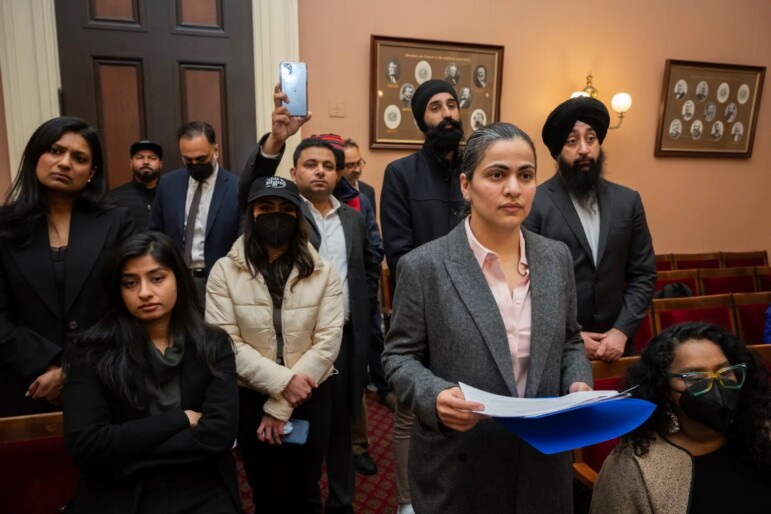For those families on Medi-Cal, the state’s insurance program for the poor, it can be even more complicated, writes CalMatters health reporter Ana B. Ibarra. Six months after the state restarted its health insurance eligibility process, more than 835,000 people who had their Medi-Cal terminated between June and October lost that coverage because of incomplete or missing paperwork.
California also ranks the fourth worst in the country in terms of coverage terminations related to “procedural issues,” according to a tracker by KFF (formerly The Kaiser Family Foundation). Under this category, the reasons why eligible people lose coverage vary: People are unprepared; they’re unaware the verification process restarted; they moved and did not receive the renewal alerts; or they did submit their paperwork but county offices may not have processed them on time.
In response, the assistant deputy director at the California Department of Health Care Services said the state has been receiving assistance from the federal government to increase the number of cases that can be renewed automatically. Eligible people who lose their Medi-Cal also have a chance to re-enroll if they submit any missing information within a 90-day grace period.
To learn more about Californians losing Medi-Cal coverage, read Ana’s story.
Speaking of health care, California faces a significant shortage of nurses, and it partly falls on universities to train more to replace those who are retiring or leaving the state.
Christopher Buchanan and Jacqueline Munis of CalMatters’ College Journalism Network report that private nursing schools are teaching more students each year, filling in the gaps as public universities struggle to grow their nursing programs.
In 2021, 55% of the 16,600 spots in associate, bachelor’s, and master’s degree nursing programs were at private institutions. Nearly 64,300 students applied, according to the California Board of Registered Nursing. Private nursing programs, which can cost up to seven times as much as public programs, also accounted for three times the number of students graduating with bachelor’s degrees as their public counterparts.
Nevertheless, a leader of the California Nursing Association union warned that if admissions for public schools stagnate and private school prices remain high, California could still lose more potential nurses to other states.
Read more about California private nursing programs in Christopher and Jacqueline’s story.
Health care includes mental health, and Gov. Gavin Newsom wants to make significant changes. But nearly all counties are slow to adopt one of the most major reforms that Newsom helped push — and he is not happy.
As Ana and CalMatters health reporter Kristen Hwang explain, the governor signed a law in October to significantly loosen the requirements around who can be placed involuntarily into mental health treatment. Fifty-six out of the state’s 58 counties have requested permission to delay the conservatorship policy until 2026, drawing ire from the governor during a Friday press conference: “The state has done its job. It’s time for the counties to do their job…. We can’t afford to wait.”
But county leaders argue that given the soaring number of people who need treatment, it’s important to implement the law right. Until they receive more guidance and secure resources for training and infrastructure, the lack of staff and funding make it difficult to move the new law forward.
- Nora Vargas, San Diego County board of supervisors chairperson, in a statement to CalMatters: “San Diego County will implement (the conservatorship law) in a way that is methodical and equitable because these are real people and real families seeking care.”
Read more about Newsom’s reaction to the roll out in Kristen and Ana’s story.
Recall against legislator moves ahead

State Sen. Aisha Wahab couldn’t get her contentious bill on caste discrimination across the finish line. And now the Fremont Democrat faces the very real prospect of a recall election.
On Friday, the Secretary of State’s office cleared the recall campaign to start collecting signatures — at least 42,802 valid ones are required by May 23 to qualify for the ballot.
The recall launched in May; a campaign committee reported raising more than $95,000 as of Sept. 30, with $74,000 in available cash. One of the organizers, past congressional candidate Ritesh Tandon, cites poor performance by Wahab, but has also said he opposed the bill.
Wahab didn’t have any immediate comment, but has said that she had heard the recall would be dropped if the caste bill went away.
- Wahab: “The recall, sadly, is to bully state legislators or policymakers as a whole to do what these individuals want.”
Wahab, whose first term goes through 2026, also said she received threats after introducing the bill, which divided the South Asian community. Some said that the state needed to explicitly ban discrimination based on caste, the centuries-old social hierarchy system that has determined employment or education. But others said it wasn’t necessary and would unfairly target South Asians.
Wahab softened language in parts of the bill to get it through the Legislature near the end of the session. But Gov. Newsom vetoed the measure on Oct. 7.
If this recall goes before voters in Alameda and Santa Clara counties, it would be the first of a state official since the spectacularly unsuccessful bid to remove Newsom from office in 2021.
In more election news: The Secretary of State on Friday also declared that Assemblymember Vince Fong can’t run for Congress, since he already qualified on the ballot for his legislative seat. “State law prohibits any candidate from filing nomination papers for more than one office at the same election,” the office said.
The timeline: Former House Speaker Kevin McCarthy announced his exit on Dec. 6. Fong said he wouldn’t run on Dec. 7, but had already filed to run for his Assembly seat before the Dec. 8 deadline. On Dec. 10, state Sen. Shannon Grove announced she wouldn’t run. Fong announced he had changed his mind on Dec. 11, two days before the deadline to file for McCarthy’s seat.
Fong, as you might imagine, is not happy and plans to sue to try to overturn the decision, which he calls “unprecedented interference” and would prevent him from trying to succeed his fellow Bakersfield Republican and mentor.
- Fong, in a statement: “Voters in the 20th Congressional District have a right to choose the candidate of their choice to represent them in Congress. I will fight the Secretary of State’s misguided decision and do whatever it takes to give voters in our community a real choice in this election.”
State GOP Chairperson Jessica Millan Patterson accused Democrats of trying to make the safe Republican seat more competitive. “The Sacramento Democrat machine should not get to put their thumb on the scale,” she said in a statement.
The battle for Klamath water

Between saving the fishes or the ranches — and the cultures and economies that rely on them — the State Water Resources Control Board is expected to decide Tuesday whether to extend emergency drought measures that will impact two key Klamath River tributaries.
But as CalMatters Rachel Becker explains, the interest of several stakeholders clash as they all vie for the water board to either continue or end the emergency measures. On one side are tribes in the lower Klamath Basin, wildlife agencies and the fishing industry who advocate for flows that support the rivers. Amid plummeting salmon populations, commercial and tribal fishing remain essential to their businesses and culture. The water board is also considering the possibility of permanently keeping more water in the rivers, though that decision could take years and will entail clearing state requirements.
- Arron Troy Hockaday, Karuk Tribal Council member and a fifth generation traditional fisherman: “I’ll fight until I can’t breathe anymore for these fish. And I hope my grandson and my sons and even my granddaughter will keep up the fight until they’re protected.”
But farmers and ranchers also need the water for the cattle and crops that drive the Siskiyou County economy. Their financial tolls from water cuts include losses in hay production, costs to install more efficient irrigation systems and selling off of cows.
With the state no longer in drought, they argue that the newest round of regulations is yet another example of bureaucratic meddling, and they wonder why their livelihoods — which are financially tenuous already — are singled out when mining, flood control projects and forest management also drain the rivers.
- Jim Morris, a farmer in Scott Valley: “Ag is not like having an 8-to-5 job. You need to make money when you can, because the next year, you won’t.”
For more on the battle over the Scott and Shasta rivers, read Rachel’s story.
